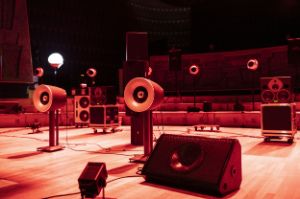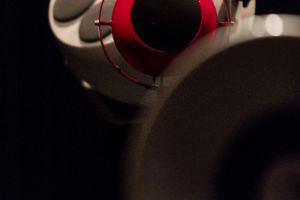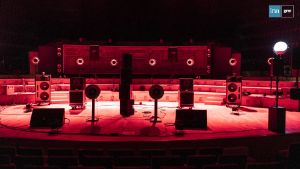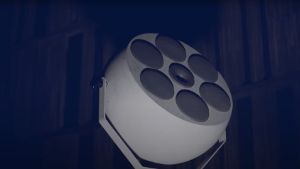
The Acousmonium at the Festival Présences électronique
Photo: Didier Allard, © INA grm
The Loudspeaker Orchestra: Acousmonium
Listening without Recognising
Since the 1950s, composers have grappled with the question of how to effectively showcase musique concrète and electroacoustic works in concert settings. This endeavour has been driven by a growing fascination with evolving recording and studio technology, which at the same time has enabled the exploration of preserved and processed sounds worldwide in the early 20th century. The concept of the loudspeaker orchestra – tightly linked to this question – has not only encouraged a new exploration of listening as an experience but has also opened up new possibilities of how listening can be continually configured and reconfigured through technological realms.
“We learned, in electro-acoustic music with Schaeffer, to change our point of view, to hear something which is a sound and not that which produced the sound. If it’s a car, a voice, a violin, we’d hear this too, but we could hear something else. I don’t know how others do music, but I do music with this other kind of hearing.”
Beatriz Ferreyra
1
Speakersinsteadofperformers
Acousmonium
The Acousmonium is an orchestra of loudspeakers arranged not merely at the front of the auditorium but dispersed entirely throughout it. The orchestra’s “conductor” transmits the musical work into the room using a control panel that regulates the diffusion. The arrangement of the loudspeakers and thus the shape of the Acousmonium can change depending on the piece. Designed in 1974 by François Bayle as a member of the Groupe de Recherches Musicales (GRM), the Acousmonium was put into action later that year at Espace Cardin in Paris. Today, it is still mainly used for the presentation of acousmatic works, although it is also increasingly being used to perform interdisciplinary forms of music, improvised music and multimedia.
Over the years, the Acousmonium has undergone technological upgrades as well as conceptual changes. The settings for the performance of any given acousmatic work are already determined in the studio as part of the compositional phase. The aim of the performance, then, is mainly about realising the inherent possibilities of the work by taking full advantage of the physical space. In doing so, the loudspeaker orchestra creates a connection to the immersive qualities of the sound, emphasising the transformative communal quality of music.

Photo: Didier Allard, © INA grm
INA grm
Founded in 1958 by Pierre Schaffer from the Groupe de Recherches de Musique Concrète (GRMC), the Groupe de Recherches Musicales (GRM) represents one among several theoretical and at the same time experimental working groups that comprised part of the French radio’s “Service de la Recherche” from 1960. Still based in Paris and part of the Institut National de l’Audiovisuel (INA) since 1975, GRM is dedicated to preserving and promoting the cultural heritage of sound. Numerous composers who have been influential for musique concrète are associated with the group, including Pierre Henry, Pierre Schaeffer, Éliane Radigue, François Bayle, Guy Reibel, Bernard Parmegiani, Luc Ferrari, Beatriz Ferreyra and Ivo Malec.

Pierre Schaeffer at the phonogène – a multi-speed, keyboard-controlled tape player, 1955 © Serge Lido

2
TheLegacyofINAgrm
Challenging Habits
As acousmatic concerts strive to confront the inception and reception of sound, these experiences are increasingly challenged by the fragmented nature of modern listening habits. Over the past couple of decades, these habits have been dominated by compressed audio files played on computer speakers, portable speakers and earbuds, often distributed by digital streaming platforms.
Amidst these sensory and experiential evolutions and technological revolutions, the legacy of INA grm (Groupe de Recherches Musicales) and musique concrète assumes a pivotal role. François Bonnet notes that INA grm has been crucial in challenging traditions of classical music and instruments, redefining the conception and perception of sound itself, both as source material and process. It has been at the forefront of questioning the very notion of composing music within the Western canon while introducing new ideas about “writing” music and engaging with the materiality of sound.
“The acoustic images projected by loudspeakers shake up the way we approach the issue of the contact point between the music and the audience. This new situation forces us to take a position on new issues, and introduces us to new reactions. This diversely poetic music gathers around a common denominator: the listening system.”
François Bayle
3
MusicasaSensoryExperience
3D-Phenomena of Sound
Composers on other continents grappled with similar questions. In 1944 in Cairo, Halim El-Dabh asserted “the purest form of relation to this world is through sound, the sound that comes before the invention of modern musical instruments.” While in the 1960s, US composer Alvin Lucier emphasised the need to shift attention from the conception and generation of sound to its propagation, stating that written notes are two-dimensional symbols of a three-dimensional phenomenon of sound.
This complex relationship between listeners and technological immersion bestows the audience a sensory experience not solely heightened by the visual realm or the physical dimensions of hearing; rather, it binds the spatial experience and music presentation together.
The essence of the festival’s opening lies in questioning, reshaping and dealing with listening habits, writing and technological devices that disperse sound. In this realm of acousmatic experiences, listeners discover heightened perceptions, propelled into realms and dimensions of musical depths. This convergence aligns with the ongoing exploration by composers and acousticians to forge novel situations where composition might draw inspiration from the evolving aesthetics unravelled with the manipulation of audio technology. The interplay between composition and perception creates a transcendent auditory experience that resonates through time, reflecting a continuous dialogue between artistic innovation and the possibilities of sound perception and its propagation, historically and today.
The Acousmonium at MaerzMusik 2024
Special thanks to INA grm







